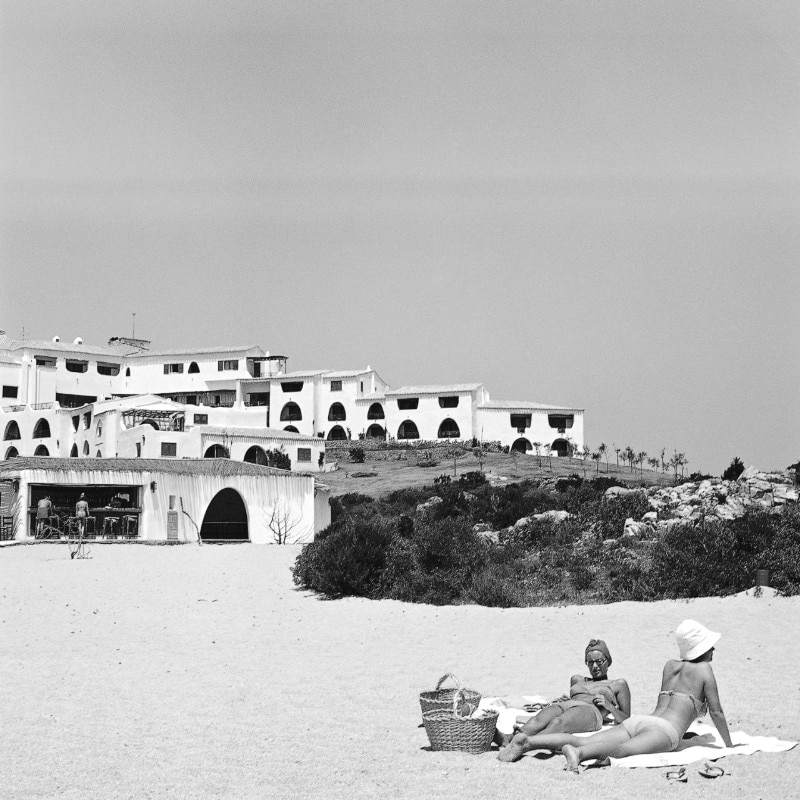by Lorenzo Ottone
At the dawn of the 1960s, John Duncan Miller, a Cambridge graduate and finance mogul nearing retirement, former Washington correspondent for the Times and with a past in the British intelligence services in the American capital, finds himself sailing off the coast of north-western Sardinia.
On his return to London, word about the extraordinary and still unspoiled territories of Gallura spreads in the financial clubs of the Big Smoke. Listening to him is Prince Shah Karim Al Hussaini, a Harvard alumnus, a horse racing and skiing fanatic (in 1964 he will represent Iran in the Winter Olympics in Innsbruck) with a history PhD on sight that had vanished just a few years earlier. In 1957, on the death of his grandfather, the young man had in fact ascended to god-like status, inheriting religious and political powers straight from Mohammed, becoming the Imam of the Ismaili Muslims under the name of Aga Khan IV.
What may read like the beginning of a Guy Ritchie’s screenplay or a novel by John Le Carré, actually is the antecedent to the birth of one of the most desirable tourist and residential settlements in Europe, as well as one of the most pioneering in terms of sustainability and land preservation: Porto Cervo. After all, those who hang in (or rather, have hanged) this strip of the Sardinian coastline are well accustomed to the fact that, there, reality always surpasses fantasy.
The origins of the dream
Mesmerised by the crystal-clear waters and uncontaminated territory, Karim Aga Khan had the vision of transforming this portion of Sardinia – which falls under the municipality of Arzachena and, in part, Olbia, in the province of Sassari – into a buen retiro for himself and a few intimate members of the international jet-set of the dolce vita
On 14 March 1962, in Olbia, in the presence of lawyer Mario Altea di Tempio, a handful of signatories led by the Prince sealed the birth of the Consorzio Costa Smeralda. Among them, on top of Duncan Miller, were lawyer André Ardoin, Patrick Guinness, heir to the legendary Irish brewing family, writer René Podbielski and Felix Gray, Aga Khan's right-hand man.
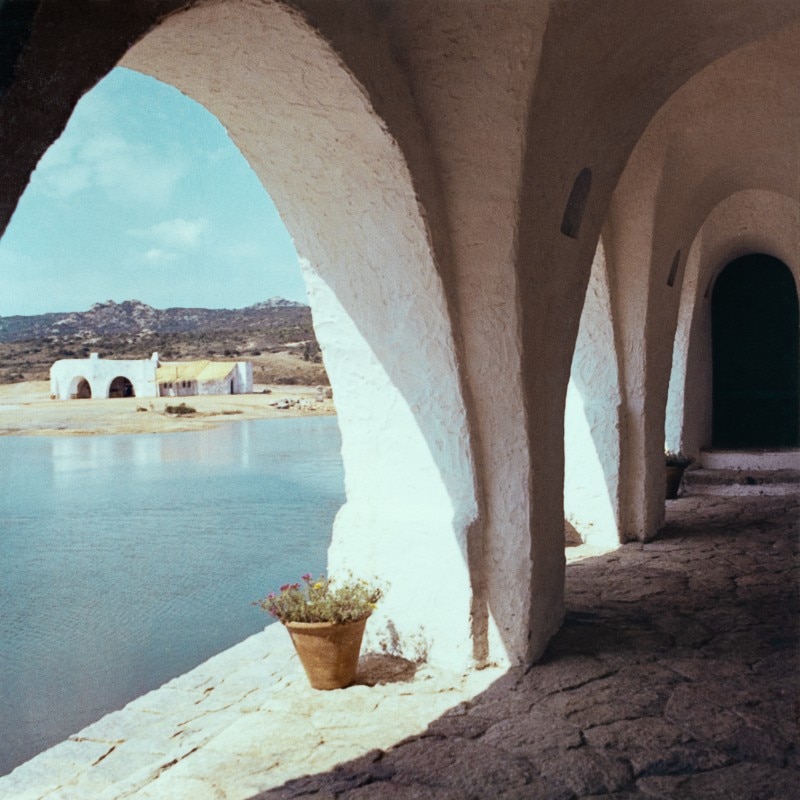
Two large granite blocks, the same the local signs were made of, engraved with the words Costa Smeralda and the Consortium's logo were subsequently laid to mark the 1,800 hectares of land mostly purchased from two local families, the Orecchioni and the Azara. With the deed, the term Costa Smeralda was also born. Although it has mistakenly become part of our common language, it does not correspond to any geographical toponym. The Consorzio is keen to point out that the correct nomenclature is the rather elegant “area consortile”, freely translating to areas under the control of the consortium.
"It was like a hunting reserve: there were no houses, there was no running water, no electricity, no businesses of any kind,” Prince Aga Khan once stated.
Following the foundation of Porto Cervo, several of the families that had sold their land to Aga Khan would become the first new settlers of the municipality, opening their businesses and promoting a further development of the area.
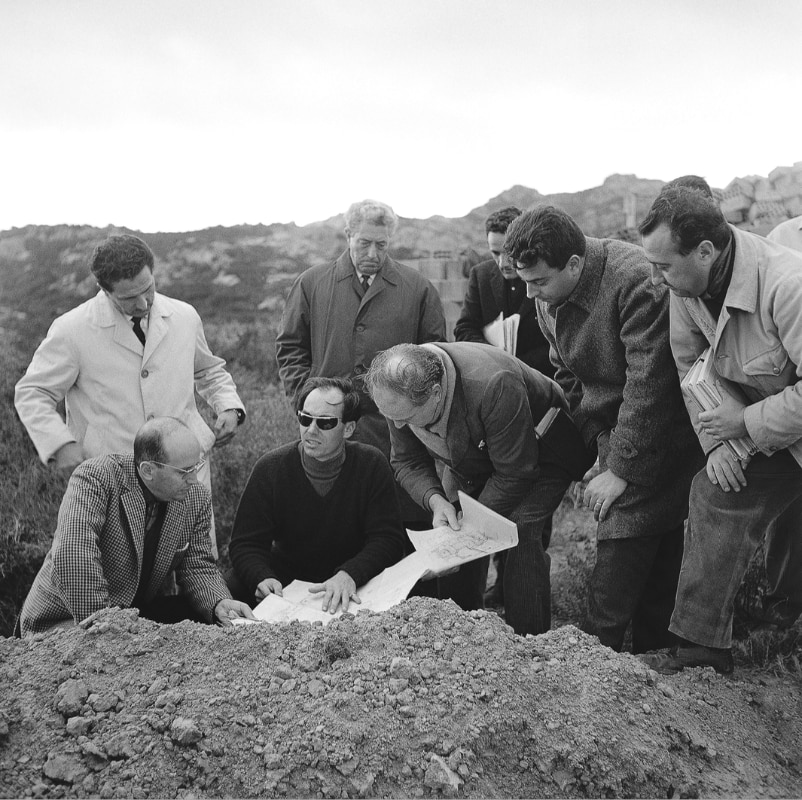
Pan-Mediterranean architecture and landscape conservation
As if the Prince wanted to emphasise that Poltu Celvu, as the people of Gallura call it, was a place that belonged more to the realm of dreams than the one of reality, at first he did not commission an orthodox architect for the building development of the settlement, but rather a self-taught scenographer, the Frenchman Jacques Couëlle, also known as the “billionaires architect”. His practice, moving between architecture and sculpture, which shares the organic principles of Antonio Gaudi’s, is the result of studies on form and materials carried out since the mid-1940s by his Research centre of natural structures.
Overseeing operations, like a para-state arbiter, is the Consorzio. Among the guidelines dictated for the urban expansion of Porto Cervo is a far-sighted search for harmony with the surrounding natural territory, inspired by Aga Khan and in stark contrast to what in those years was taking place on other Italian coasts. While on the Romagna riviera, the myth of affordable holidays within everyone's reach was born by erecting modernist hotels which suffocated with concrete the autochthonous landscape, in Gallura the Prince-Imam was determined to protect, and thus celebrate, the indigenous buildings, acting as a guardian of the island's millenary tradition and biodiversity.
All power lines were buried underground, and the Consorzio set up its own fire brigade, medical centre, rubbish collection and security guards.
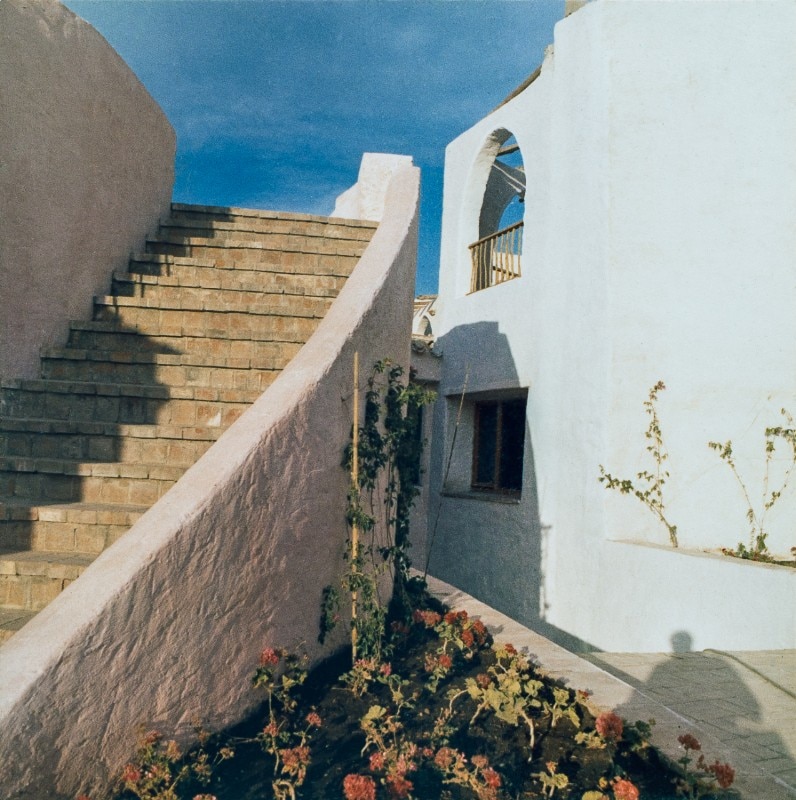
Among the illustrious architects commissioned over the years are Michele Busiri Vici, Antonio Simon Mossa and Luigi Vietti, already responsible for the renovation of several Ligurian marinas, as well as the jet-setting holiday destinations of Cortina d’Ampezzo and Portofino. Vietti is from Piedmont, as if to suggest – ironically – that the fate of Sardinia remained a Savoy affair. He didn’t simply let the surrounding morphology inspire him, but forged from scratch an architecture destined to become a paradigm of the pan-Mediterranean style. A meta-architecture that projected into the then present what could have been the building styles of the Gallura region if only geo-economic conditions had not previously prevented its development. Today we would be talking about an AI-generated, speculatively realistic landscape.
The white, irregular surfaces of Porto Cervo’s houses are smooth and blunted, carved into the rock, in opposition to the geometric rigour of the city. We witness a celebration of poor materials such as wood and the rope of fishing nets, alongside the rediscovery in a chic and luxury key of indigenous materials, such as coral, which returns to be sought after for jewellery and artefacts. This is also narrated by former partisan turned maritime documentarist Bruno Vailati in a fragment of Alla Scoperta del Mare (Discovering the Sea), one of his many works from the 1970s for Italian state television RAI.
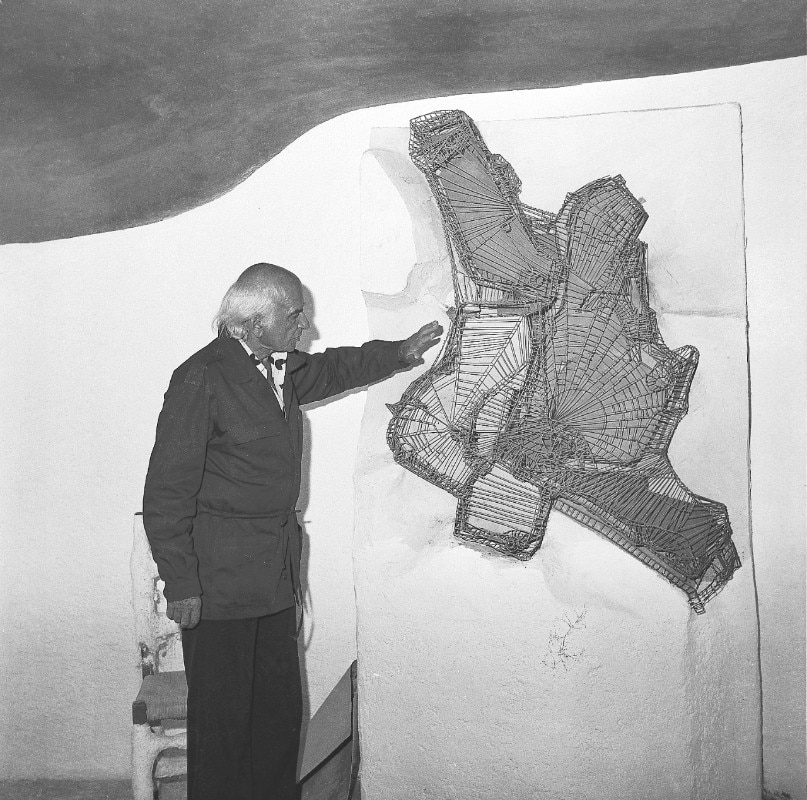
The safe haven of the international jet-set
In Porto Cervo, Aga Khan traced a silver lining with the holiday architecture of the continental noblesse. Rustic-chic became the dominant leisure style in years when fields gave way to skyscrapers, wood to plastic and harvests to supermarkets. All those urban places that, even on a culinary level, aimed to portray escapism and genuinity became to go in the opposite direction of that advertised by trade publications. Take, for instance, the restaurant area of the then uber hip Roman teen joint Piper Club, which adopted wooden seats and table cloths in white and red checks in the style of old fashioned taverns. Or the famous 1961 project by Achille and Pier Giacomo Castiglioni for the Splügen Bräu brewery in Corso Europa, Milan, which simultaneously combined modernist design solutions with vernacular Bavarian elements, mainly to be found in the wooden surfaces and beer glasses. In Porto Rotondo, not far from Porto Cervo, one of the most historic discos, although opened over a decade later, was named Country Club.
The international jet-set thus forged its own apparently pauperist holiday aesthetic, which echoed from the Côte d’Azur of Brigitte Bardot and Gunter Sachs to the Greece of Onassis, from the Corsica of the Savoy family in their gilded exile to, inevitably, the Sardinia of the Agnellis and Aga Khans.
To better welcome the founding members’ guests and the first holidaymakers, in 1963 the Consorzio Costa Smeralda promoted the birth of the airline Alisarda (later Meridiana and Airitaly), at whose chairmanship another key figure of the Aga Khan entourage, lawyer Paolo Ricciardi, sat for over twenty years. Poorly connected to the island’s air access points, four years later Porto Cervo was given its own airport, Olbia-Costa Smeralda. The foundation of the prestigious Costa Smeralda Yacht Club also dates back to the same year. With it, the Hotel Cervo, the Pedro’s night club in Liscia di Vacca and Villa Cerbiatta became the first recognisable landmarks of the territory’s urbanisation. Impossible not to mention is the famous Piazzetta Rossa, the central Red Square, officially from the colour of its flooring. However, one is left to wonder whether it is a nod to the champagne-socialist ambitions of many devotees of the Sardinian summers of the times.
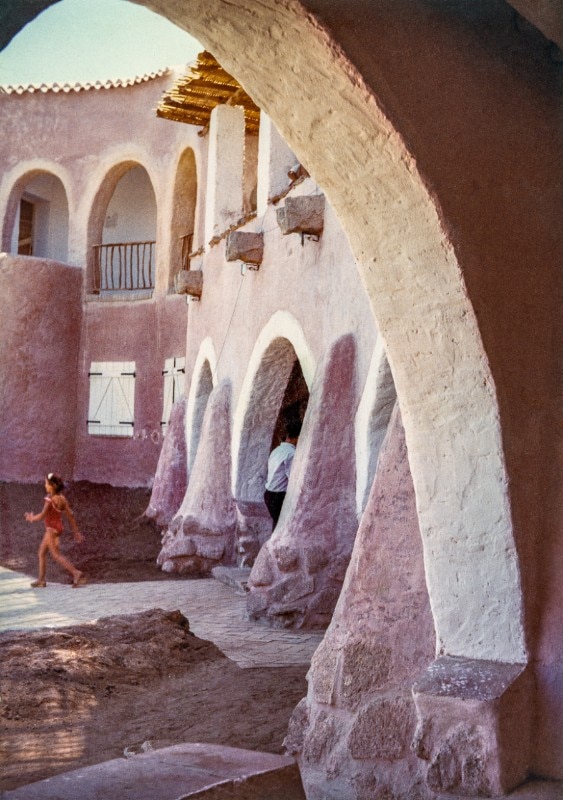
Among these was the fashion designer and socialite Marina Ripa di Meana, who had also opened her own boutique in nearby Porto Rotondo. Her companion, artist and resolutely anti-Bourgeois Franco Angeli, decorated its walls with a painting of a tiger chasing the shop owner, naked.
Angeli in those years had one of his main patrons in the lawyer and entrepreneur Gianni Agnelli, another close friend of the Aga Khan and a frequent visitor to Porto Cervo. The FIAT patron had cut his teeth, amorously and socially, on the roaring French Riviera of the 1950s, alongside playboy accolades including Porfirio Rubirosa and a yet to become Imam Karim Aga Khan. But his bond with Porto Cervo ran deep, in ties of blood and territory. The family of his wife, Marella Caracciolo, scion of the Neapolitan nobility, had been among the promoters of the area’s economic development, while Prince Karim's grandmother, the dancer Teresa Magliano was, like the Avvocato, from Turin (once again, the long Savoy hand on Sardinia). Suggesting how multiple generations of Aga Khans didn’t mind to indulge in overlapping the sacred and the profane.
In a very popular Facebook group, “Professionals of the Costa Smeralda of yesterday and today”, memories, obituaries and photographs of staff, themed parties and celebrities are posted daily. Like the one of the Hotel Cala di Volpe barman's daughter, who kept the 16,200 Lire receipt of a dinner held by the Avvocato Agnelli on 18th July 1970: food, two coffees, two vodkas and a grappa to call it a night. And then another from 1968, paid for with a $100 deposit.
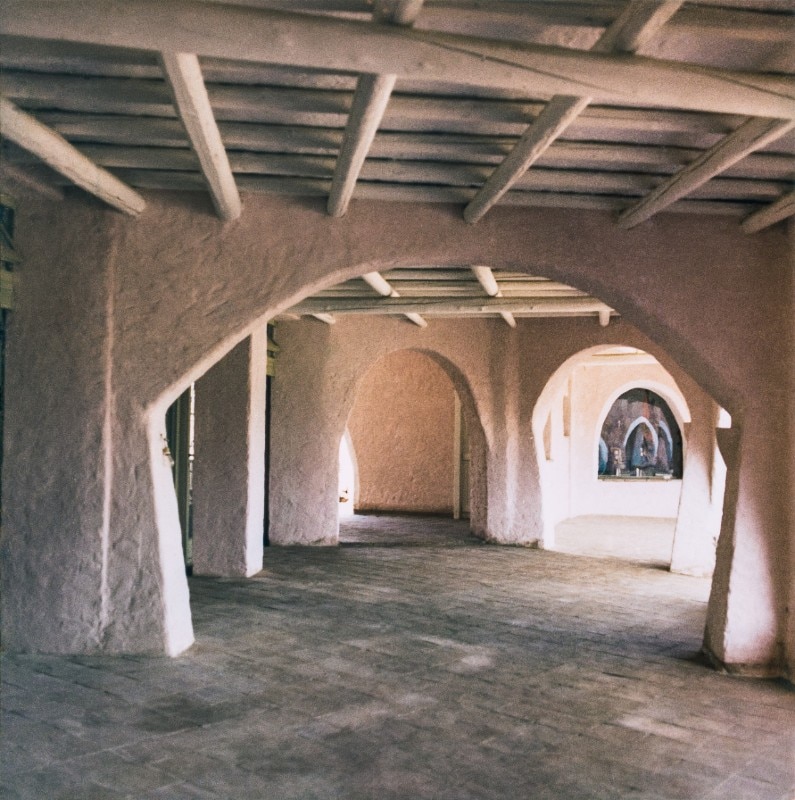
Politics and scandals in the sun
“I used to go to Capri when the countesses acted like whores, now that the whores act like countesses I no longer enjoy it,” is one of the most famous quotes attributed to Gianni Agnelli, the flamboyant tombeur des femmes and FIAT and Juventus chief. Adapting it to his Emerald past, one can trace a certain decline of the founding model forged by Aga Khan. As far back as 1970, actor and director Alberto Sordi bitterly joked on the myth of the democratisation of luxury in the omnibus film “Le Coppie”. One of its cult scenes is indeed set at Porto Cervo’s Hotel Romazzino, where we witness an abrasive confrontation between the decaying but still ruffian nobility and the new mass tourism of the self-embarrassing nouveau riche.
The 2000s were the years that most marked the renewed notoriety of Porto Cervo and its coast in public opinion, a watershed with the tradition established by the founding fathers, not only in economic terms, but also ethically. The roaring years of the low rise, not just a fashion but a mindset as brilliantly commented by writer Alberto Arbasino. Of the rise of F1 mogul Flavio Briatore with his club Billionaire, of the new height of the paparazzi craze and of showbiz demiurge Lele Mora, of the love affairs between showgirls and footballers, with their long gel-greased hair kept in place by questionable headbands. But also the days of the summer embassy, with the Iraqi war in full swing, between a bandana-clad Silvio Berlusconi and his British counterpart Tony Blair, similarly dressed in white.
In 2007, Italian journalist Beppe Severgnini argued how the Gallurese coast had been preserved over the years from a natural point of view, but not socially and culturally since the VIPs took over. Around this time the local government tried to curb this tourism – still continental and foreign as in the tradition of Porto Cervo, but no doubt tackier and more rowdy – by introducing taxes on luxury properties, such as villas and yachts over 14 metres. Briatore would claim the right to wealth in an evening of protest at his Billionaire disco, Berlusconi would end up paying more than 50,000 Euros on his holiday mansion, while revenant pop star Zucchero would get into a bottle fight with a group of Arab tourists accused of not paying attention to his show at an exclusive club.
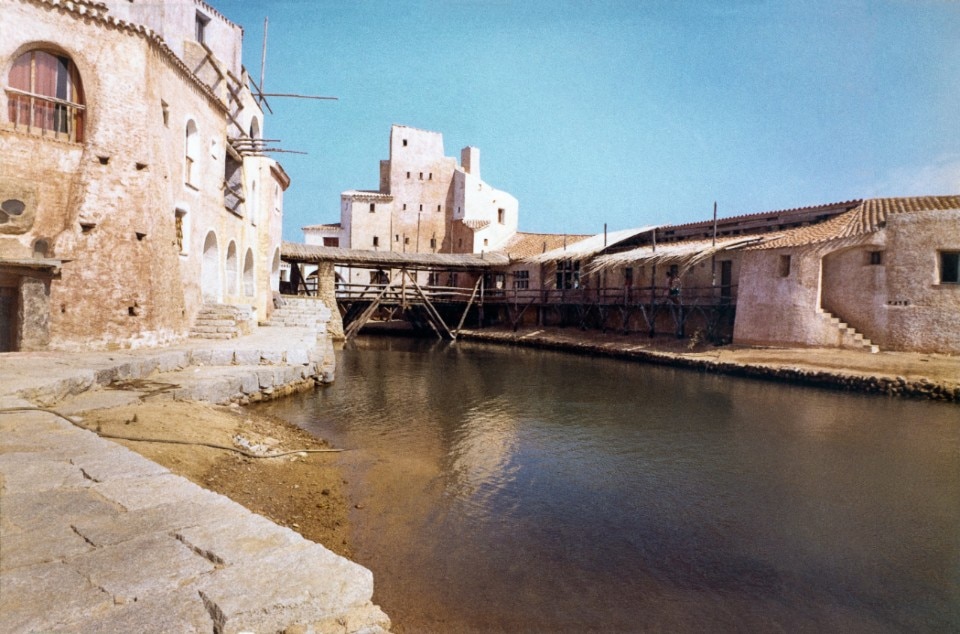
The 60th anniversary of Porto Cervo
Last summer, the Consorzio Costa Smeralda blew out its first sixty candles. Many were the celebratory initiatives, including a photo book commissioned by the consortium itself, featuring wonderful shots by Slim Aarons, rare images of the likes of actor Ugo Tognazzi at dinner with friends, and details of Jacques Couëlle’s villa. This year Assouline, the same publishing house, has just dropped a new editorial project, this time dedicated to Hotel Cala di Volpe, an illustrious architectural landmark of Porto Cervo.
Today, the Consorzio Costa Smeralda – of which Smeralda Holding is the main partner with its Hotel Cervo, Hotel Cala di Volpe, Hotel Pitrizza and Hotel Romazzino – also has its own official press, the monthly CS Journal. On the front page, it dispenses information on golf tournaments to follow in the summer, keeps up-to-date on the various prizes awarded to illustrious holidaymakers, and does not disdain to offer insights into indigenous archaeology and interviews with the barmen and maîtres who have made history on this unique morphological and anthropological strip of Sardinian coastline. A publishing reality that reaffirms the indispensable elegance of the ephemeral, and which is undoubtedly more compelling than much of the national press during the summer months.
Opening image: The charme of the first architectures and holiday goers of Porto Cervo. Credits: Nello Di Salvo, Coast Magazine.


